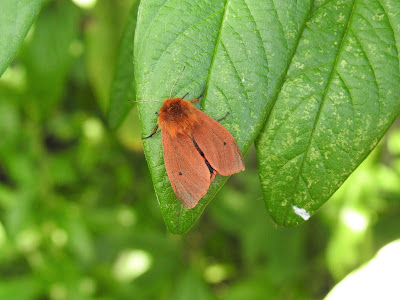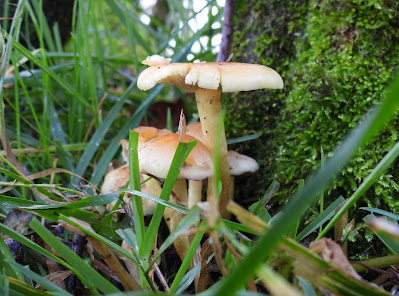I suppose it is winter now, we've had the first frosts, and we've even had a few snow flurries, which for us is unusual for November. Autumn seems to have slipped by without much of a fanfare, which is such a shame, as October is probably one of, if not the best, birding month of the year. Part of the problem for us, was not being able to access the reedbed and scrub at the Nature Park, because of a person or persons unknown, camping in the area we carry out our survey work. We lost the whole of October because of this, and it wasn't until the 8th November that the campers were removed. Being philosophical about it, that's how it goes sometimes.
My blog posts seem to have slipped to become fortnightly, or even monthly, summaries, and I'm not sure how that has happened. And this post is no different, as I'm going back to the 27th October to kick things off.
Gail and I started off at the Mount Park under five oktas cloud cover, with a 2 - 3 south-westerly wind, to see if there was any vis. After half an hour spent here, it was obvious very quickly, that there wasn't any vis, as all we had was a Grey Wagtail west.
We then headed to the Quay to have a walk from there to the mouth of the estuary. The first thing that made it into my notebook from here, was a lovely Red Admiral. Out on the mud in the quay were 68 Redshanks, and 27 Oystercatchers. When we got to the mouth of the estuary, we could see that at least a thousand Oystercatchers were feeding on Great Knott.
There was little vis here as well, and all we had were 55 Jackdaws heading south-east, and a female Sparrowhawk that flew west across the estuary, that may, or may not have been moving. It was certainly heading in the right direction for this time of year over the peninsula.
At the end of October, we had a walk around the Nature Park, and this doubled up as an opportunity to check if the tent was still in our ringing area. It was another grey day, and the wind was still fixed in the west. As usual, the soundtrack to the site was that of the explosive song of the Cetti's Warbler, and we had two singing birds. The vis was once again thin on the ground, with just a handful of Chaffinches, and Skylarks south.
one of the pools
Out on the pools were eleven Shovelers, two Little Grebes, 20 Coots, five Tufted Ducks, 14 Moorhens, 57 Mallards, 32 Black-headed Gulls, and out on the river 32 Wigeon.
In early November, in fact on the day that a certain percentage of the UK population, attempts to disturb wildlife by putting matches to gunpowder, in so called fireworks, allegedly celebrating some dodgy historic event that probably half of the people celebrating have no idea about, we had a walk down to the salt-marshes on the River Wyre. It was yet another grey day, but the wind had swung round to the south-east.
The public footpath winds its way through Hawthorn scrub on a raised bank, and at least 25 Blackbirds, a Song Thrush, and eight Redwings fed on the berry laden branches. We headed upstream, and past the reservoir that held 27 Tufted Ducks, a Coot, five Moorhens, three Mallards, a Mute Swan, four Little Grebes, and four Goldeneyes.
The tide was already up to the edge of the saltmarsh and filling the tidal creeks, and it flushed a Rock Pipit, and a Jack Snipe, with the latter being our first for the autumn. We were just in time to count 37 Wigeon, and 200 Lapwings, before these too were dispersed by the incoming tide.
On our walk back, the ever elusive Kingfisher was again heard and not seen, and from the scrub by the old railway line we had a Bullfinch calling, which is fairly uncommon in this part of the Fylde. We came across some Hogweed that was flowering, and as might be expected, it had a few insects on it.
We had our first Fieldfares of the autumn the following day when we had a flock of 150 head south over the house.
Continuing with the winter thrush theme, Gail and I had our last ringing session at the Nature Park for the year a couple of weeks ago. We were there early to get our nets up in the dark, with the aim of trying to ring Redwings in particular.
We ringed 18 birds as follows (recaptures in brackets):
Redwing - 7
Long-tailed Tit - 1
Reed Bunting - 3
Goldfinch - 1
Greenfinch - 6
Blue Tit - (1)
Dunnock - (1)
Whilst we were extracting the Redwings, Gail commented that they were like "autumn in a bird", because of the autumnal colours of their plumage; from reds through to burnt orange, with every shade of brown in between. I think Gail is right!
In addition to the Redwings that we ringed, we had somewhere in the region of 77 Redwings, and 37 Fieldfares during the early morning, so not huge numbers. The vis was yet again quiet, with just handfuls of Lesser Redpoll (technically just Redpoll now), Greenfinch, Chaffinch, Woodpigeon, and Skylark over. On one net round when we walking into the reeds and scrub, we flushed a Woodcock which was our first of the autumn.
We found two species of fungi in our net rides, but we could only get them down to family; Gallerina sp., and Trametes sp.
As you would expect, insects are getting scarce as we move into winter, but on warmer days I have had a few queen Buff-tailed Bumblebees on the wing.
A few days later, we were back at the Quay and the Wyre estuary. In the car park is a large clump of Ivy, hanging over the fence from a neighbouring garden, and it was still full of blow flies, hover flies and wasps. It's such a good late source of nectar.
The tide was dropping, and a few waders were dropping in on the freshly exposed mud including 31 Redshanks, 22 Black-tailed Godwits, and a Knot. Out on the river were six Little Egrets, eight Oystercatchers, and three Curlews.
Fog rolled in about half an hour after we set off, causing the temperature to drop, and quieten everything down as if under a blanket of cotton wool. A Common Drone Fly on some Yarrow certainly wasn't for moving in the now cool, and damp conditions.
As we headed back to the car we came across a Ruby Tiger caterpillar hurriedly making its way across the quay. Caterpillar food plants include Ragworts, Plantains, Dock, and Dandelion, of which there are plenty at the quay.
Our feeding station is up and running now at our good friend's farm near Nateby, and we are just topping it up about every 6 - 7 days at the moment. Tree Sparrows, Greenfinches, Goldfinches, Chaffinches, Blue, Great, and Coal Tits are all busily feeding away. On one of our visits we had a flock of 180 Golden Plovers fly over heading south, and it made me think that Golden Plovers always seem to be in a hurry! In a field gateway in the bottom of the hedge we came across some Sulphur Tuft fungi, but it was past its best.
As I have mentioned numerous times before, I love looking at all my notebooks that I have going back to 1977, and I like to randomly get one of the shelf and have a delve in. On this day (25th November) in 1984, I was at Marton Mere Local Nature Reserve (LNR), and some of my counts really stand out. These include 57 Tufted Ducks, 60 Shovelers, three Ruddy Ducks, 35 Pochards, and 20 Grey Partridge! Nothing unusual, but boy have things changed!
Over on the right you will see that I have updated the ringing totals for Fylde Ringing Group up until the end of October. No new species were ringed for the year during the month, and only Redwing made it into double figures with 22 ringed.
Below you will find the top 10 'movers and shakers' for the year.
Top 10 Movers and Shakers for the Year
1. Siskin - 112 (same position)
2. Meadow Pipit - 94 (same position)
3. Blue Tit - 90 (same position)
4. Goldfinch - 47 (same position)
5. Reed Warbler - 44 (same position)
6. Great Tit - 42 (down from 5th)
7. Chaffinch - 35 (same position)
8. Tree Sparrow - 34 (down from 7th)
9. Redwing - 25 (straight in)
10. Greenfinch - 21 (down from 9th)




















